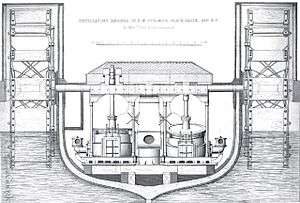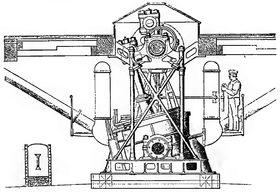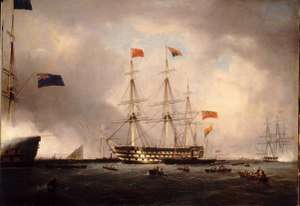HMS Black Eagle
 Oscillating paddlewheel engines of HMS Black Eagle | |
| History | |
|---|---|
| Name: |
|
| Owner: | Royal Navy |
| Ordered: | 28 January 1831 |
| Builder: | Merchant's yard, Limehouse |
| Cost: | £19,964[1] |
| Laid down: | April 1831 |
| Launched: | 11 July 1831 |
| Commissioned: | 11 July 1831 |
| Fate: | Broken up, March 1876 |
| General characteristics [1] | |
| Class and type: | Firebrand-class steam vessel |
| Displacement: | As built: 510 tonnes |
| Tons burthen: |
As built: 495 bm From 1843: 540 bm |
| Length: |
|
| Beam: | 26 ft 5 in (8.1 m) |
| Depth of hold: | 14 ft 10 in (4.5 m) |
| Propulsion: | |
| Complement: | 80 |
| Armament: |
|
HMS Firebrand was a wooden paddle vessel launched in 1831. She was rebuilt in 1843, renamed HMS Black Eagle and employed as an Admiralty steam yacht. She was broken up in 1876.
Construction and rebuild

Built at Merchant's Yard, Limehouse as a wooden paddle vessel, Firebrand was launched on 11 July 1831.[2] In 1832 her original Butterley side lever steam engine was removed and replaced in 1833 by a Maudsley, and Morgan's paddlewheels were fitted. She was rebuilt in 1843, gaining 13 feet (4.0 m) in length, and receiving a oscillating engine manufactured by John Penn and Sons. Notably, Penn doubled the power output without increasing either the weight or space occupied.[3] Firebrand was renamed Black Eagle on 5 February 1842.[1]
In 1856,[4]the Black Eagle and the paddle-wheel troopship Dee were used in a trial of J Wethered's apparatus for superheated steam. This produced an economy of fuel of 18% in the Black Eagle, and 31% in the Dee.[5]
| Engine usage 1843–47 | ||||||||||
|---|---|---|---|---|---|---|---|---|---|---|
| Year | Distance steamed | Coal burnt | Distance per ton of coal | Days under repair | Source | |||||
| nautical miles |
miles | km | long tons | tonnes | long tons per nautical mile |
tonnes per km | ||||
| 1843 | 2,104 | 2,421 | 3,897 | 334 | 339 | 6.3 | 3.5 | 5 | [6] | |
| 1844 | 5,402 | 6,217 | 10,005 | 629 | 639 | 8.6 | 4.7 | - | [6] | |
| 1845 | 6,852 | 7,885 | 12,690 | 826 | 839 | 8.3 | 4.6 | 24 | [6] | |
| 1846 | 2,898 | 3,335 | 5,367 | 430 | 440 | 6.7 | 3.7 | 78 | [6] | |
| 1847 | 3,537 | 4,070 | 6,551 | 558 | 567 | 6.3 | 3.5 | 68 | [6] | |
Royal Yacht

She was based at Woolwich in south-east London and was part of the Royal Squadron alongside the Royal Yacht. The Black Eagle was eventually broken up at Portsmouth in March 1876.[7] A model of the vessel is in the collection of the National Maritime Museum.[8]
References
- 1 2 3 Winfield (2004), p.162
- ↑ HMS Black Eagle in Naval Data Base
- ↑ "Past Presidents", Institution of Mechanical Engineers, p. 1858-59 John Penn
- ↑ Brown, Before the ironclad, page 51 says that the Black Eagle was used to try Wethered's superheater in 1856; Brown does not mention that the Dee was also used.
Busk, The navies of the world, page 152 makes it clear that the trials of superheaters on the Dee and the Black Eagle were about the same time. - ↑ Busk, Hans (1859), The navies of the world, Routledge, Warnes and Routledge, p. 152
- 1 2 3 4 5 Brown, David K (1990), Before the ironclad, Conway, p. 57, ISBN 0851775322
- ↑ "HMS Black Eagle", Phillips and Carpenter Family History
- ↑ Paddle Yacht ‘Black Eagle’ 1831 (SLR0736) Archived 2010-11-23 at the Wayback Machine.
- Winfield, Rif & Lyon, David (2004). The Sail and Steam Navy List: All the Ships of the Royal Navy 1815–1889. London: Chatham Publishing. ISBN 978-1-86176-032-6. OCLC 52620555.